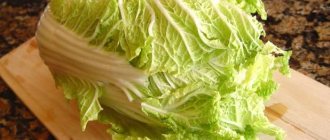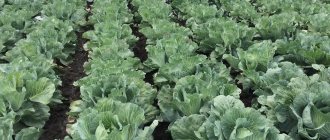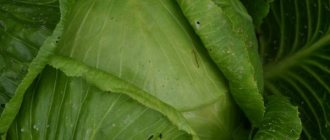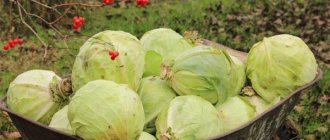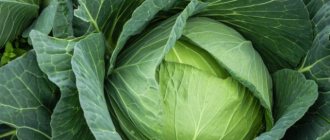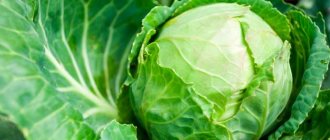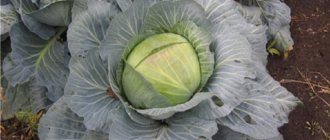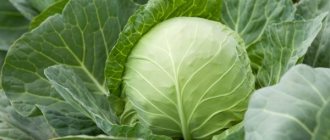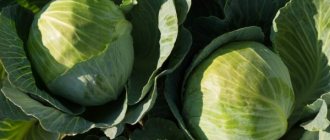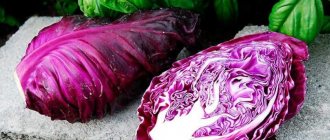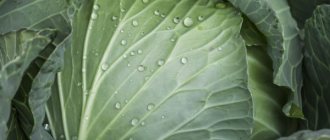White cabbage Russian size is distinguished by especially large heads of cabbage. If you provide them with proper care, they can reach 15 kg. Some consumers are afraid of vegetables of this size, but there is no need to be afraid - the variety does not contain GMOs or dangerous genes, it is obtained naturally.
| Landing location | Ripening time | View | Purpose | Origin | Maturation period | Weight |
| Open ground | Mid-season | White cabbage | Fresh, Long-term storage, Pickling, Cooking, Processing | Variety | 120-145 | 4-15 |
Description of cabbage Russian size
Russian size is a variety for growing in open ground. The growing season of the vegetable is 135-145 days. The ideal planting pattern for an agricultural crop is 70x50 cm. The variety loves sunlight very much, so when choosing a planting site you need to pay attention to this point.
Russian size is an exclusive variety produced by the manufacturer Russian Ogorod. Heads of this variety can reach 15 kg, of course, if all growing conditions are met. Considering the large size of the “heads”, the Russian size is ideal for processing.
The heads of cabbage have a rounded flat shape and are white in cross section. Very juicy, thanks to which they make very tasty sauerkraut. The heads of cabbage are dense in structure, therefore suitable for long-term transportation over long distances, without loss of presentation.
This is a very water-loving variety. Without high-quality and regular watering, you will not be able to get a good harvest. Also, cabbage does not tolerate drought well.
Cauliflower “Russian size” 0.1g TM Siberian Garden
Description
All our seeds do not contain Genetically Modified Organisms.
No harm to health. The seeds comply with the requirements of international standards and GOST RF 12260-81.
Cabbage "Russian size".
late ripening variety. The fruits can weigh up to 4 kg. The ripening period averages 120 days after germination of the first shoots. The heads are large, dense, snow-white, round in shape. Excellent for storage, the heads do not crack. Used in cooking both fresh and processed. Can be used for freezing or canning. Cabbage, especially this variety, contains a very large amount of vitamins, minerals and other useful microelements. It is especially useful for cardiovascular diseases. In addition, cabbage strengthens the nervous system. Transportability is high.
Advantages of the variety:
- record large heads of cabbage;
- great taste;
- universal use;
- easy care.
Agricultural technology for growing cabbage seeds
Cabbage is one of the vegetable crops that can be stored fresh throughout the year after harvest.
Fresh salads, borscht, pickling - this is not a complete list of dishes where cabbage is a key component. Even novice summer residents can grow such a vegetable on their own. Technology of growing from seeds
- With proper care, cabbage seeds get along well both in open ground and in specially prepared containers placed indoors.
- If the second (greenhouse) option is chosen, then the seeds are sown in a container 8 weeks before the pre-selected date for planting seedlings in already open ground.
- The correct depth for cabbage seeds in the prepared substrate is a maximum of 1 cm.
- Until the first shoots, it is worth maintaining constant climatic conditions in the room: the soil is consistently moist, and the operating temperature is about 21 ° C.
- If everything is done correctly, the first shoots should be observed within 2-3 weeks.
- You should immediately attend to the issue of good lighting for young seedlings. This can either be a sunny window sill or alternatively use a fluorescent light.
- The device itself is placed at a distance of about 10 cm from the cabbage sprouts, and the duration of illumination should be about 16 hours a day.
- Standard incandescent lamps are not suitable - along with the lighting, a lot of excess heat is released, which harms the plant.
- The main thing when growing seedlings is not to overdo it with care: you should not use artificial lighting for the entire 24 hours and you certainly do not need to apply an excessive amount of fertilizer.
- In cases where cabbage seeds were initially planted in containers with a small working area, then over time it is advisable to transplant them into pots with a diameter of at least 7-10 cm.
- The seedlings will be ready for open ground when the seedlings have 3 pairs of leaves.
- However, you should not immediately transplant cabbage into new conditions - first there is a “hardening” process.
- For the first week, it is enough to take the container outside, selecting moderate conditions: the absence of sharp winds, cold weather and strong sun.
- Only after a week of “trial period” will the plant be ready for final replanting.
Sowing seeds in open ground
- The initial conditions are standard for most crops: the presence of fertile and moist soil along with a sufficient amount of sunlight.
- Vegetable seeds can be sown in early spring.
- Unloading into the soil is carried out in separate rows, maintaining an interval of about 50 cm.
- As soon as the seeds are distributed in even proportions, they are sprinkled with a thin layer of earth up to 1 cm thick, but no more.
- Before the formation of the first shoots (10-21 days from the moment of planting), it is worth making sure that the soil is not dry - it is enough to keep it slightly moist.
- As soon as the height of the plant reaches 5-7 cm, the young shoots should be thinned out so that there is a clear space of about 60 cm between individual seedlings.
Care during growth
- In order for cabbage to grow properly, it is necessary to regularly cultivate the soil, eliminating all emerging weeds.
- The methods themselves are standard: regular cultivation or the same mulch will solve the problem in this case, the main thing is not to damage the sensitive root system of the seedlings when weeding.
- Regular watering, which is vital during dry periods, can qualitatively accelerate the growth of vegetables.
- Cabbage, as a crop, is subject to the negative effects of a number of diseases and animal pests, so if necessary, it is worth taking appropriate measures.
Harvesting and canning
- A clear signal for harvesting occurs when the heads of vegetable take on a solid shape.
- The fruit is carefully cut from the stem, after which unnecessary outer foliage is removed.
- If weather conditions allow, then new head embryos are highly likely to form on the stem.
- After harvesting the autumn harvest, harvested cabbage is well preserved for several months after being cut.
- It is advisable to preserve the culture under the following conditions: storage temperature +5°C with high environmental humidity.
Advantages of purchasing grape seedlings at Agro-Market24
- We value every customer, therefore we sell high-quality seedlings with a maximum survival rate
- Delivery is carried out carefully and in the shortest possible time
- Loyalty program, sweepstakes, promotions and bonuses
- Compliance with varietal and taste qualities
Cultivation
It is best to plant this vegetable through seedlings. This method of planting will make it possible to plant fairly large and strong seedlings in well-warmed soil, thereby ensuring them better survival on the site.
The seeds are planted approximately 2 months before the planned transplantation into the OG. Usually in the central part of the Russian Federation this time falls at the end of March - beginning of April. Seed planting depth Russian size – 1-1.5 cm. The soil should be moist at the time of planting. After placing the seed in the soil, the soil is not watered until the first shoots appear. Only then can you start watering.
If the seeds were planted in separate containers (several pieces), then choose the tallest seedling and leave it. Further it will develop like this until the moment of dive. If the seeds were planted in a common container, then it is necessary to periodically thin out the seedlings, leaving only the largest specimens.
Care
Cabbage needs proper care
Cabbage Russian Size requires standard care:
- In the morning or evening, water with warm water every 3-4 days. This improves the adhesion of the root system to the soil. It is important that moisture does not evaporate when exposed to sunlight.
- After each watering, it is important to loosen the soil and remove weeds. Loosening the soil is necessary so that a crust does not form on the surface of the earth, otherwise oxygen and nutrients from fertilizers will not reach the roots.
- Fertilizing is carried out several times throughout the growing season. It is important to combine organic and mineral substances. The first feeding is carried out 26 days after planting the seedlings in a permanent place. A solution of organic fertilizers should be used (2 kg of humus should be diluted in 10 liters of warm water). At least 2 liters of solution must be poured under each bush. The second feeding is carried out at the flowering stage of the plant. You need to dilute 20 mg of superphosphate and 20 mg of ammonium nitrate in 10 liters of warm water. 1.5 liters of solution is poured under each plant.
Advantages and disadvantages
Naturally, a variety with such a big name should have advantages. And they are:
- In particular, the main advantage of cabbage is the large size of the head, which can reach 15 kg. Such a large vegetable is ideal for processing for the production of sauerkraut.
- Also, the heads of cabbage are very dense, which allows them to be transported without loss of commercial quality.
As for the shortcomings, there are none as such. We can only note that it is demanding when it comes to watering, but any variety of cabbage is demanding when it comes to watering.
Watering cabbage Russian size
As already noted in the description of the variety, cabbage of this variety is very demanding when it comes to watering. Therefore, watering plays a vital role when growing Russian size.
If you follow these rules, you will be able to grow a good harvest:
- It is advisable to keep the soil moist at all times. The ideal soil moisture for cabbage is 75%.
- The older the plant, the more water it needs, as the roots of the crop become longer.
- It is best to water cabbage in the early morning or evening, when the sun is least active. It is also advisable to pour water under the root without touching the leaves.
- Water the vegetable only with warm, settled water, the temperature of which is not lower than 20 degrees Celsius. Watering with cold water can not only stop the development of cabbage, but also contribute to the development of various diseases (in particular root diseases).
- 3 weeks before the planned harvest, you need to stop watering. This is necessary in order to increase the shelf life of the heads of cabbage and reduce the risk of cracking.
We recommend reading: Description of the cabbage variety Kolya F1
Russian size reviews
(no author)
Which apple will you take from the dish if you forget about the rules of good manners for a minute? Of course, the biggest thing, because it seems so ripe and delicious! Fruits of especially large size always attract attention and cause everyone's admiration. It is no coincidence that competitions are regularly held for the largest pumpkin, tomato, etc. As you know, demand creates supply.
As a result of many years of work by breeders, a new series of seeds “Russian Size” has appeared, which presents the largest-fruited varieties and hybrids of vegetables. The impressive size of the fruit is combined with excellent taste and resistance to bad weather and disease.
Sweet pepper F1 Russian size
– High-yielding hybrid of medium ripening period.
The fruits weigh up to 400 g, more than 20 cm long, are dark green at the technical stage, and red when ripe. The walls of the fruit are fleshy, 7-8 mm thick, the taste is excellent. It would seem that such huge beautiful peppers can only ripen under the generous southern sun.
Meanwhile, they feel great in the middle zone. The plants are vigorous, with genetic resistance to the tobacco mosaic virus. Fruit sets easily even in low light conditions. The fruits are well stored after harvesting and retain their presentation for a long time. Recommended for winter greenhouses, film shelters and open ground. Sowing seeds for seedlings in late February - early March.
Can one tomato feed an entire family? Without difficulty, if you don’t make a mistake with your choice. New indeterminate
Tomato F1 Russian size
It is distinguished by its huge size and excellent taste. The fruits contain a lot of organic acids, biologically active substances, and mineral salts. There are slightly more sugars than others (up to 10%), so it is classified as a dessert tomato. The plants are vigorous. The inflorescences are short, with 2-3 fruits in the cluster.
The fruits are flat-round, fleshy, multi-chambered, and bright red when ripe. Average weight is 400-600 g, maximum up to 2 kg (with normalization of the number of ovaries in the hand)! Productivity 4.0-4.5 kg per bush.
The agricultural technology of this hybrid is generally accepted; it is only important to carry out all the necessary measures efficiently and in a timely manner.
It is known that the most tender and delicious are young thin carrots. But how long and boring it is to clean it! You'll waste a lot of time, but there's almost nothing to eat. Now, if only I could find a carrot that would be large, juicy, and sweet. Now it's quite possible.
Carrot Russian size
Given its outstanding size, it will not disappoint the most demanding gourmet. The variety is mid-season, from germination to harvest 110-115 days, high-yielding. The root crop is slightly conical with a blunt tip, bright orange in color.
Length 22-24 cm, diameter up to 6 cm. On light soils, root crops of this variety reach a length of 30 cm and a weight of 1 kg! To achieve maximum size, timely thinning is necessary.
It is perfectly stored until the end of March, without losing its juiciness and consumer properties.
Connoisseurs usually choose small radishes, rightly fearing that large ones may turn out to be hollow and tough. Of course, small radishes are good, but cutting them is inconvenient. And to grate finely is generally a problem. Now imagine radishes the size of tennis balls! You cut it and see dense, juicy pulp without any voids or fibers. Fantastic? - No, it’s quite real.
Radish Russian size
The root crop is round, bright, and under optimal growing conditions reaches 10 cm in diameter. What original dishes can be prepared from it! For example, stuffed radishes. Cut the root vegetable in half and remove the core with a spoon.
Fill the resulting cup with chopped pulp with the addition of finely chopped herbs, butter, salt and spices. Real jam! But, most importantly, by growing this variety, you save a lot on seeds. After all, both an ordinary radish and a giant fruit grow from outwardly identical seeds.
Suitable for growing in open ground and film shelters.
Green peas are a favorite delicacy for children. Not only a child, but also an adult will be delighted when he sees pods full of vigorous sweet peas up to 1 cm in diameter!
Peas Russian size
It just begs to be put into your mouth! And it’s also good in preparations for the winter - you can freeze it, you can preserve it. In any form it is very tasty and does not take long to clean. The variety belongs to the peeling variety; the fruits contain a large amount of proteins, vitamins and sugars. Plants are 80-90 cm high and need support. Sowing in the ground in April - early May.
There is an opinion that you cannot grow a large “turnip” from seeds in one season. But
Onions Russian size
the path from a nigella seed to a huge bulb takes just 4-5 months. This is the largest of the bows - weighing up to 3 kg! The bulb is round, light yellow in color, very juicy.
Thanks to its delicious sweet taste and the absence of a sharp onion smell, it is excellent in salads. Mid-season. To obtain selected large bulbs, it is grown through seedlings.
Sowing in mid-March, planting hardened seedlings in the ground in early May, harvesting in July-August.
Forms a mass of fragrant greenery
Dill Russian size
height up to 145cm. The leaves are large with strongly dissected segments, the stem is tender and juicy. The taste is excellent. Not damaged by pests and diseases. From germination to flowering 70-104 days. Dill is a fairly cold-resistant crop. Seeds begin to germinate at 3-5 °C. The seedlings easily tolerate spring frosts. Sowing directly into the ground from April to July inclusive.
Have you ever seen kohlrabi the size of an adult's head? Do you think it's overgrown with hard, woody flesh? Let's cut it open and try it. The knife easily penetrates the juicy light pulp. When fresh, the slices crunch appetizingly on the teeth; when cooked, they easily turn into the most delicate puree, which, unlike potato puree, contains almost no calories.
Kohlrabi Russian size
– early ripening, less demanding on heat and soil fertility than other cabbages. The growing season is 110-120 days. You can harvest when the stem fruit reaches 6-8 cm in diameter. Later it reaches 3-5 kg without losing its taste. Sowing seedlings in the first half of May, harvesting from July.
Strawberry F1 Russian size
- an incredibly large-fruited hybrid with very tasty berries, with an average weight of 50 g. It’s not easy to put such a berry in your mouth; it’s more convenient to bite off it like an apple! It begins to ripen two weeks earlier than other varieties and bears fruit until the end of September. Characterized by high productivity.
Other articles in the issue in the “Nursing Earth” section:
Discuss the article. (Discussions: 2)
Source: https://aquariumfan.ru/%D1%80%D1%83%D1%81%D1%81%D0%BA%D0%B8%D0%B9-%D1%80%D0%B0%D0% B7%D0%BC%D0%B5%D1%80-%D0%BE%D1%82%D0%B7%D1%8B%D0%B2%D1%8B/
Loosening the soil
Loosening also plays an important role in caring for cabbage. As in the case of irrigation, there are also a number of rules, which, if followed, significantly increase the chances of getting a good harvest:
- The soil is loosened for the first time a week after dropping the seedlings from a cup (or a common container) into open ground. Just after 7-8 days the plant will take root in its new location and loosening will not harm the root system.
- The first loosening should be shallow, no deeper than 5 cm.
- The depth of subsequent loosening is from 6 to 8 cm.
- It is advisable to loosen the soil after each watering, as they significantly compress the soil, impairing the penetration of oxygen to the root system of the vegetable.
Landing rules
This crop is grown only by seedlings, so in early March you should sow the seeds to obtain seedlings. The planting depth is about 2 cm, and the distance between the seeds is 5-7 cm. After this, the container is placed in a warm place, with a temperature of about 24°C. This allows Russian Size cabbage seeds to sprout faster. After the first shoots appear, daytime temperatures should be lowered to 17°C and night temperatures to 8°C. These conditions are necessary to prepare the plant for planting in a permanent location.
Seedlings should be planted in open ground only after 2-3 pairs of leaves have formed on them - this period falls in mid-April. For planting, you need to give preference to fertile soils, with a low level of acid-base balance (no more than 5%), well-lit areas. Planting pattern 50x60 cm.
Reviews from gardeners
Svetlana Yurievna, Moscow, 43 years old.
Last year I became acquainted with “Russian size” seeds. I decided not to bother and purchase everything I needed from this manufacturer. Moreover, the neighbors said that they grew cabbage from this manufacturer, and it came out large and good. In general, I bought onion, cabbage, dill and pea seeds. What can I say. Onions have grown from seeds, but I won’t bother with seedlings anymore. The onion grew, although not of royal size, as stated by the manufacturer, but very tasty. And thanks for that. I never saw the dill, as the slugs completely devoured it. They are no longer guests in my garden, but full-fledged residents. The peas are good, but not huge. Regular peas. I was pleased with the cabbage. Really. Not 15 kg, as it was written on the package, but good in everything. Juicy, tasty, beautiful color.
Vladislav Alexandrovich, Summy, 53 years old.
At one time I remember there was a real stir. “Russian size” seeds were advertised everywhere, but it was difficult to get them; you had to order them by mail. Naturally, many were afraid, they say it was a money scam. But somehow I took a chance and bought it, it was in 2011. In general, I bought radishes and cabbage. The radishes were ordinary, nothing special, but I liked the cabbage. I planted seedlings at the end of May, as I usually do. The heads of cabbage grew large, not 15 kg each, as the manufacturer promised, but there were also heads of cabbage weighing 8 kg. Although mostly 5-6 kg, no more. What else I liked about cabbage was its taste, quite pleasant and juicy. But after that I didn’t buy cabbage from this series. Yes, it’s tasty, yes, it’s large, but there are many good varieties on the market that are in no way inferior to the “Russian size”, but at a much lower price.
The best productive varieties of cabbage for open ground
Not all cabbage varieties produce a rich harvest, even with good care. So that your energy is not wasted, and the cabbage delights you with its excellent taste, it is important to choose seeds that meet the purpose of planting.
Experienced summer residents advise a beginner to answer 3 simple questions:
- How early should the harvest ripen?
- What type of cabbage do household members prefer?
- Will the heads of cabbage be used in preparations and pickles?
Based on these requirements, you can determine the best variety of cabbage for open ground from the rating of the most common seeds.
Which white cabbage to plant in different regions
In 2021, the state plant register includes 432 white cabbage varieties. No other species can boast of such indicators. This is not surprising, because white cabbage is an ideal source of valuable elements. It easily outperforms citrus fruits in terms of the level of vitamin C in its composition and contains a rich supply of vitamin P.
The main criterion for dividing white cabbage into groups is the speed of ripening. All varieties are divided into:
- early ripening;
- mid-season;
- late.
The quality of the harvest depends on climatic conditions and soil characteristics. They also determine the growing technology. If in the Central and southern regions of the country they can usually plant cabbage of the same varieties, then for the northern regions cold-resistant seeds will be needed.
14 varieties for early harvest: a detailed review from “A” to “Z”
All early varieties have less shelf life and do not give such a high “yield” by the end of the season. These vegetables ripen faster and are usually ready for harvest within 3-4 months after planting.
Cabbage heads of early ripening are smaller in size and looser than their later counterparts. They are usually used in fresh salads, added to summer cabbage soup and vegetable stews.
Compared to other species, early varieties:
- ripen 90-120 days after the appearance of the first shoots, ready for harvest by mid-summer;
- have succulent leaves of grassy green color with a delicate structure;
- produce small loose heads of cabbage;
- unpretentious, grow well when planted densely on problematic soil.
Mid-season cabbage is slightly different from early-season cabbage:
- ripens on the 130-150th day, when the harvest from early ripening seeds has already left;
- produces dense, medium-sized heads of cabbage and high yield;
- has succulent snow-white leaves;
- more sugary;
- It is stored longer, until winter.
Mid-season varieties have long been chosen by summer residents and villagers. This cabbage is good fresh, suitable for canning and pickling.
To eat fresh, delicious cabbage all season long, you only need one bed.
Experienced gardeners often create a full-fledged conveyor by sowing an area with seeds from the table below:
| Name | Features of the variety | Application | Weight of heads of cabbage in kg | Productivity per 1 m2 in kg | Technical ripeness period in days | Disembarkation |
| Universal, for any terrain | ||||||
| June | Suitable for dry soil, tolerates frost well, not susceptible to bolting | Fresh | 1-2,5 | Until 6 | 92-100 | 3-5 plants per 1 m2 |
| Golden hectare 1432 | 1,6-3,3 | 5-8,5 | Up to 120 | According to the 50x60 pattern, without thickening | ||
| No. 1 Gribovsky-147 | 1,1-1,8 | 2,5-6,7 | 79-110 | According to the 60x60 scheme. Usually grown together with June | ||
| Polar K-206 | Fresh and for fermentation | 1,9-2,8 | 4,7-5,9 | 82-121 | ||
| Cossack | It is not afraid of frost and can easily tolerate temperatures up to +25 degrees. Gets sick less often | Fresh | 0,8-1,2 | 3,2-4,6 | 106-112 | 5-6 plants per 1 m2. Can be cultivated under film |
| Rinda | Tolerates any weather well | Fresh and for fermentation | Up to 7 | 9-9,5 | 75-80 | 3-5 plants per 1 m2 |
| Tobia | Heads of cabbage do not wither or crack without moisture | Fresh | Up to 7 | 4-7 | Up to 90 | 2-3 plants per 1 m2 |
| Slava 1305 | Fresh, for fermentation, in cooking | 2,4-4,5 | Up to 12 | 115-120 | According to the 60x60 scheme, the holes are pre-watered and the soil is compacted | |
| Hope | Tolerates lack of watering without cracking | Fresh and for fermentation | 3-3,5 | 7,5-11,9 | 120-130 | According to the 60x40 pattern with recess to the first leaves |
| Cold-resistant, zoned for northern latitudes | ||||||
| Arctic | Resistant to cold, loves light and moisture | Fresh | 1-1,5 | Up to 9 | 90-97 | According to the 50x40 scheme |
| Junior | Can be planted in dense rows | 1,4-1,8 | 3,5-5,8 | 100-110 | According to the 60x30 scheme. Grows well in soil where legumes, cucumbers, and root vegetables were grown | |
| Siberian | Heads of cabbage do not crack and ripen even in cold weather | Fresh and in soups | 2,1-4,3 | 3,4-8,6 | 44-55 | According to the 70x50 scheme. Seedlings need regular watering |
| Florin | Lasts longer than others | Fresh, for fermentation, in cooking | 2,3-4,5 | 3,4-6,6 | 140-145 | |
| Belorusskaya 455 | Loves light, grows steadily in frosts down to -4 degrees | For fermentation | 1,5-3,9 | 5,1-7,3 | 85-100 | According to the 50x50 scheme |
10 delicious late varieties for long-term storage and pickling
80% of known cabbage varieties are seeds of a long growing season. They produce the largest harvest and help stock up on fresh vegetables, pickles and preserves for the whole year. Late cabbage has its own distinctive features:
- ripens longer, approximately 160-210 days;
- has coarser leaves with a characteristic “bitterness”;
- “arrives” during storage and becomes even tastier;
- produces dense, crispy forks;
- stored for about 7 months at a certain temperature.
Late-ripening varieties are usually grown with a “reserve”. If you store your supplies in the cold, you can eat fresh cabbage all winter, until the start of the new season. This is a universal option for any culinary purpose.
Seeds can be planted directly into the ground, the main thing is to comply with the planting time. If you plant them earlier, the ripe heads will crack and lose their attractive appearance. By delaying planting, the gardener loses his own harvest - the heads of cabbage turn out to be small and loose.
The best “output” in different regions is given by:
| Name | Features of the variety | Weight of heads of cabbage in kg | Productivity per 1 m2 in kg | Technical ripeness period in days | Disembarkation |
| Universal, for any terrain | |||||
| Moskovskaya late 15 | It does not crack, is not afraid of pests, and has juicy, tender flesh. Shelf life: 6-8 months | 3,5-5 | 10-12 | 143-160 | 2-3 plants per 1 m2. Seedlings must be fed and watered abundantly |
| Valentina | Protected from fusarium wilt and gray rot, it has a sweetish taste. Stored until July | 3-4 | Up to 16 | 155-180 | 2-4 plants per 1 m2 |
| Kolobok | Has good immunity against spot necrosis and thrips. Stores up to 10 months | 2-3 | Up to 12 | 145-150 | 3-4 plants per 1 m2 |
| Mara | The heads of cabbage do not crack and do not accumulate nitrates or radionuclides. Can be stored for more than 7 months | 3 | Up to 9 | 160-175 | According to the 60x60 scheme, the holes are pre-watered |
| Lennox | 1,6-2,4 | 4,5-10,6 | 167-174 | According to the 60x50 scheme with a depth of 6-7 cm | |
| Extra | 2,5-2,8 | 5-6 | 154-170 | According to the 60x40 scheme in the sun | |
| Cold-resistant, zoned for northern latitudes | |||||
| Orion | Does not suffer from fusarium and bacteriosis, produces a bountiful harvest, regardless of the weather | 3,9-4,8 | To 10 | 165-170 | 1-2 plants per 1-1.5 m2 |
| Amager | Protected from pests, loves moisture. Does not tolerate heat well and is susceptible to bacteriosis and fusarium. Can be stored for more than 6 months | 3-4 | Up to 12 | 120-147 | 3-4 plants per 1 m2 |
| Aggressor | Produces large forks with crisp, aromatic leaves. Does not require complex care, is not afraid of fusarium and thrips | 3-5 | 4,3-6,5 | 120-150 | According to the 60x70 scheme with preliminary placement of fertilizer in the hole |
| Present | Not picky about soil composition, not afraid of frost | 2,5-4,5 | To 10 | Up to 145 | According to the 60x50 scheme |
varieties of red cabbage
Red cabbage varieties are less common in Russia, but in vain. In terms of the content of vitamins and microminerals, they can easily outperform their white cabbage “relative.” The vegetable is stored for a long time, has a pleasant taste, and has excellent dietary characteristics.
“Blue” cabbage is often used in fresh salad recipes and used as a side dish. There are types that can be pickled and fermented for the winter.
Various seeds can be planted directly into the ground or pre-sown under cabbage seedlings. Red cabbage takes longer to ripen, but is practically not afraid of pests, frosts, and typical “garden” diseases.
Experienced farmers recommend harvesting as late as possible. It is better if the cabbage “survives” the first frost while in the ground. Cold will not spoil the quality of the product if you allow the root to thaw, and this will only improve the taste.
Kalibros (Kalibos) – for lovers of beauty in the garden
This variety of cabbage is the real queen of the garden bed. No other type of vegetable can boast such an unusual teardrop-shaped shape.
The heads of cabbage, elongated in the form of a rose bud, are a pity to pick, let alone eat. But it is impossible to resist the temptation - Calibos perfectly reveals its taste in any dish.
Due to its delicate structure without rough veins, cabbage can even be eaten fresh.
The juicy, sweetish leaves have a deep red-violet color and form dense leaves weighing up to 2.5 kg. As a rule, 120 days are enough for the crop to ripen. The plant copes well with temperature changes and is not afraid of moderate frosts or high humidity. Supplies can be stored for up to four months.
Gako 741 – for conservative summer residents
Gako is the most recognizable variety of “blue” cabbage in the CIS countries. It is classified as medium-late; usually vegetables are ready for consumption 5 months after planting. Mature heads of cabbage are large in size, weighing up to three kilograms. Flattened, rounded forks are formed from purple-gray leaves with a waxy texture.
Gako 741 is unpretentious and grows well in problematic soil. You can store vegetables until the start of a new season - over time, the taste becomes even softer and more pleasant, and the “bitterness” disappears.
Primero – for those who need it faster
Summer residents love Primero for its versatility. The seeds are very productive, suitable for early planting and late season planting. Primero ripens faster than other representatives of the rating; plants are ready for harvest in 75-80 days. Another argument is resistance to cracking, frost, and typical diseases.
Primero forks have a rich purple color with contrasting white veins. The leaves are juicy and not bitter. On average, one head of cabbage weighs up to two kilograms. They can be grown for home consumption in salads and even for sale - the plant is perfectly preserved during transportation and looks attractive.
Varna – for the most thrifty
Varna F1 is a Japanese hybrid that has already been appreciated by many gardeners. The variety attracts with its beautiful shape and neat appearance, is stored for a very long time, and is not demanding on the watering regime. The harvest ripens within three months after planting. Cabbage has bright purple elongated heads. Due to their density, small-looking heads of cabbage weigh up to three kilograms.
Delicious salads and pickles are prepared from this cabbage variety. Caring for the plant is very simple - it tolerates heat well and practically does not get sick. From one meter plot of land you can get up to 10 kilograms of vegetables.
The most unpretentious Chinese cabbage seeds for the lazy
They began to grow Chinese cabbage in Russia quite recently. Because of its thin, very soft-edged leaves, many people classify it as a salad. In fact, this is a full representative of the cruciferous group.
Chinese cabbage is used in many culinary recipes - salads, soups, preserves, marinades. Even a beginner will get a good harvest by planting special hybrids:
- Russian size . The hybrid was developed by domestic breeders and provides excellent yield, even in difficult climatic conditions. The oblong-shaped heads weigh up to 4 kg and ripen in 75-80 days on any soil.
- Cha-cha . The cabbage variety is recommended for use in northern latitudes and the Urals. From the moment of sowing to the start of harvesting, only 55 days pass. This period can be shortened if you prepare the seedlings in advance. The average fork weighs up to three kilograms.
- Orange tangerine . The variety got its name for its unusual “red” core. The heads ripen in 40 days and are small in size - usually the heads weigh no more than one kilogram. They tolerate frost without problems and give excellent results when placed closely in the garden bed. You can plant the seeds in batches, producing several harvests throughout the season.
- Nika . The seeds are prepared for planting in open ground or under film. This is a hardy variety that is not susceptible to common diseases. The shoots produce curly light green leaves that form large three-kilogram heads of cabbage. The dense leaves are used to make salads or stewed.
- Stonefly . To quickly get a harvest of fresh Chinese cabbage, many people use this variety. Disease-resistant and unpretentious Springfly produces a bountiful harvest within 35 days. Dense heads of cabbage do not crack and consist of juicy, tasty leaves.
Source: https://seloveselo.ru/vegetables/cabbage/samye-luchshie-urozhajnye-sorta-kapusty-dlya-otkrytogo-grunta.html

